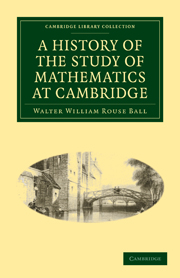Book contents
- Frontmatter
- PREFACE
- Contents
- Chapter I Mediæval mathematics
- Chapter II The mathematics of the renaissance
- Chapter III The commencement of modern mathematics
- Chapter IV The life and works of Newton
- Chapter V The rise of the Newtonian school
- Chapter VI The later Newtonian school
- Chapter VII The analytical school
- Chapter VIII The organization and subjects of education
- Chapter IX The exercises in the schools
- Chapter X The mathematical tripos
- Chapter XI Outlines of the history of the university
- INDEX
Chapter II - The mathematics of the renaissance
Published online by Cambridge University Press: 07 September 2010
- Frontmatter
- PREFACE
- Contents
- Chapter I Mediæval mathematics
- Chapter II The mathematics of the renaissance
- Chapter III The commencement of modern mathematics
- Chapter IV The life and works of Newton
- Chapter V The rise of the Newtonian school
- Chapter VI The later Newtonian school
- Chapter VII The analytical school
- Chapter VIII The organization and subjects of education
- Chapter IX The exercises in the schools
- Chapter X The mathematical tripos
- Chapter XI Outlines of the history of the university
- INDEX
Summary
The close of the mediæval period is contemporaneous with the beginning of the modern world. The reformation and the revival of the study of literature flooded Europe with new ideas, and to these causes we must in mathematics add the fact that the crowds of Greek refugees who escaped to Italy after the fall of Constantinople brought with them the original works and the traditions of Greek science. At the same time the invention of printing (in the fifteenth century) gave facilities for disseminating knowledge which made these causes incomparably more potent than they would have been a few centuries earlier.
It was some years before the English universities felt the full force of the new movement, but in 1535 the reign of the schoolmen at Cambridge was brought to an abrupt end by “the royal injunctions” of that year (see p. 244). Those injunctions were followed by the suppression of the monasteries and the schools thereto attached, and thus the whole system of mediæval education was destroyed. Then ensued a time of great confusion. The number of students fell, so that the entries for the decade ending 1547 are probably the lowest in the whole seven centuries of the history of the university.
The writings of Tonstall and Recorde, and the fact that most of the English mathematicians of the time came from Cambridge seem to shew that mathematics was then regularly taught, and of course according to the statutes it still constituted the course for the M.A. degree. But it is also clear that it was only beginning to grow into an important study, and was not usually read except by bachelors, and probably by only a few of them.
- Type
- Chapter
- Information
- A History of the Study of Mathematics at Cambridge , pp. 12 - 32Publisher: Cambridge University PressPrint publication year: 2009First published in: 1889



